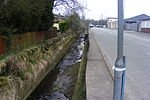Rutland Mill
1907 establishments in England1993 disestablishments in EnglandBuildings and structures demolished in 1993Demolished buildings and structures in Greater ManchesterDemolished manufacturing buildings and structures ... and 5 more
Former textile mills in the United KingdomIndustrial buildings completed in 1907Shaw and CromptonTextile mills in the Metropolitan Borough of OldhamTextile mills owned by the Lancashire Cotton Corporation
Rutland Mill was a cotton spinning mill on Linney Lane, in Shaw and Crompton, Greater Manchester, England. It was built by F. W. Dixon & Son in 1907 for the Rutland Mill Co. Ltd. It was taken over by the Lancashire Cotton Corporation in 1935. By 1964, it was in the Courtaulds Group. In the late 1980s, as Courtaulds moved operations to other parts of the world, the mill was bought by Littlewoods who demolished it and replaced it with a new automated storage warehouse.
Excerpt from the Wikipedia article Rutland Mill (License: CC BY-SA 3.0, Authors).Rutland Mill
Linney Lane,
Geographical coordinates (GPS) Address Nearby Places Show on map
Geographical coordinates (GPS)
| Latitude | Longitude |
|---|---|
| N 53.5808 ° | E -2.0876 ° |
Address
Linney Lane
Linney Lane
OL2 8HB , Wood End
England, United Kingdom
Open on Google Maps








